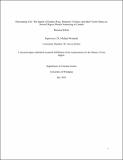| dc.contributor.author | Belisle, Breanna | |
| dc.date.accessioned | 2021-09-08T19:50:00Z | |
| dc.date.available | 2021-09-08T19:50:00Z | |
| dc.date.issued | 2021-08-12 | |
| dc.identifier.citation | Belisle, Breanna. Discounting Life: The Impact of Gender, Race, Domestic Violence, and Ideal Victim Status on Second Degree Murder Sentencing in Canada; A research paper submitted in partial fulfillment of the requirements for the Master of Arts degree, Department of Criminal Justice, University of Winnipeg. Winnipeg, Manitoba, Canada: University of Winnipeg, 2021. DOI: 10.36939/ir.202109081443. | en_US |
| dc.identifier.uri | https://hdl.handle.net/10680/1971 | |
| dc.description.abstract | Scholars, the media, and the public have been concerned about differing values placed on crime victims on the basis of social factors such as gender, race, and domestic violence affiliation. Some academics argue that specific victim attributes result in more punitive sentencing to be imposed, particularly if the victim is constructed as “ideal”. An ideal victim is one who is socially constructed as more “worthy” than another victim of crime based on personal attributes, behaviors and situational aspects of their victimization. International and domestic Canadian sentencing research, however, has demonstrated inconsistent results regarding the role of key victim attributes of gender, race and domestic violence status in sentencing. This study uses the theoretical perspective of social constructionism to guide an assessment of what impact victim gender, race, and domestic violence affiliation may have on sentencing and evaluate the effect of other “ideal victim” factors on court sanctions. The research design also considers the perspective of legal rationalism and the influence of legal factors such as past criminal history, as well as aggravating and mitigating circumstances considered by judges in their sentencing decision. The study uses the crime of second-degree murder and the outcome of parole ineligibility length to test research hypotheses. Through legal case reports and media coverage, data was gathered on victim and offender demographic, social situation and legal background data on 259 cases of second degree murder from 1980-2017. There was little support for the influence of race and domestic violence attributes on murder sentencing. Gender did appear to increase sentence punitivity, even after control variables were introduced. Consistent with past research, demographic factors and ideal victim situational factors showed mostly weak effects on sentencing, while legal predictors such as prior criminal history, other aggravating and mitigating factors explained considerably more variance in parole ineligibility. Given the high evidentiary burden of second degree murder and its seriousness as a crime, it may be an offence less likely to show bias at the point of sentence. Researchers investigating bias might be better served examining manslaughter, assault and less serious offences. Given the limited evidence of domestic violence bias, it may be that governments should provide more resources directly to family violence offenders for rehabilitation and victims for social support. Finally, results should be interpreted cautiously given sampling limitations. | en_US |
| dc.description.sponsorship | Social Sciences and Humanities Research Council (SSHRC) | en_US |
| dc.language.iso | en | en_US |
| dc.publisher | University of Winnipeg | en_US |
| dc.rights | info:eu-repo/semantics/openAccess | en_US |
| dc.subject | Ideal victim | en_US |
| dc.subject | Homicide | en_US |
| dc.subject | Sentencing | en_US |
| dc.subject | Gender | en_US |
| dc.subject | Race | en_US |
| dc.subject | Domestic violence | en_US |
| dc.title | Discounting Life: The Impact of Gender, Race, Domestic Violence, and Ideal Victim Status on Second Degree Murder Sentencing in Canada | en_US |
| dc.type | Thesis | en_US |
| dc.description.degree | Master of Arts in Criminal Justice | en_US |
| dc.publisher.grantor | University of Winnipeg | en_US |
| dc.identifier.doi | 10.36939/ir.202109081443 | en_US |
| thesis.degree.discipline | Criminal Justice | |
| thesis.degree.level | masters | |
| thesis.degree.name | Master of Arts in Criminal Justice | |
| thesis.degree.grantor | University of Winnipeg | |

